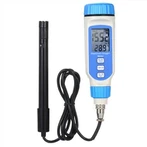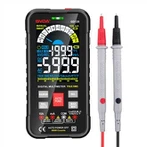Steps to measure resistance with a digital multimeter
A multimeter measures resistance by outputting a small current into a circuit. The standard unit is the ohm (Ω). Since current flows through all possible channels between the probes, the resistance reading represents the total resistance of all channels between the probes.
Multimeters have segmented resistance ranges, such as the Fluke 87V/C, with resistance stops of 600.0 Ω, 6,000 kΩ, 60.00 kΩ, 600.0 kΩ, 6,000 MΩ, and 50.00 MΩ. To avoid damage to the multimeter or the equipment under test, turn off the power to the circuit and discharge all high-voltage capacitors before measuring resistance with a digital multimeter.
Steps for measuring resistance with a digital multimeter
1) Disconnect the power supply of the circuit
2) Select resistance (Ω).
3) Insert the black test probe into the COM input jack. Insert the red test probe into the Ω input jack.
4) Connect the tip of the probe at both ends of the component or shorted part where the resistance is to be measured.
5) Take a reading and be sure to note the unit of measurement - Ohms (Ω), Kilo-Ohms (kΩ) or Mega-Ohms (MΩ).
1,000 Ω = 1 kΩ 1,000,000 Ω = 1 MΩ
Ensure that the power is turned off before making resistance measurements.
Tips for Measuring Resistance with a Digital Multimeter
The following are some tips for measuring resistance with a digital multimeter:
1) Since the test current of the meter has to flow through all possible paths between the two probes, the resistance value measured at a particular resistor on the circuit is usually different from the rated value of the resistor.
2) When making resistance measurements, the test lead will introduce an error of 0.1 Ω to 0.2 Ω. To measure the resistance of a wire, touch the probe tips together and read the resistance of the wire. If necessary, you can automatically subtract this resistance value using the relative value (REL) mode of the multimeter.
3) In resistance mode, the meter outputs a voltage sufficient to turn on the forward bias of a silicon diode or transistor on the circuit. If in doubt, press C to apply a lower current in a higher range. If the resultant value is greater, select the larger value. See Table 18. continuity is a quick "pass/fail" resistance test used to distinguish between open and closed circuits.






